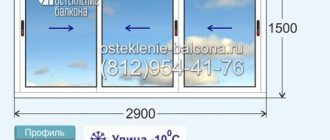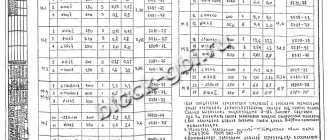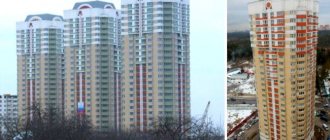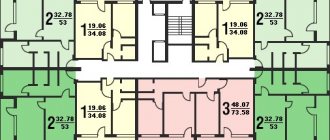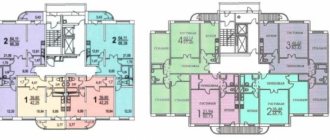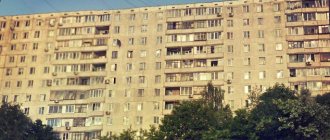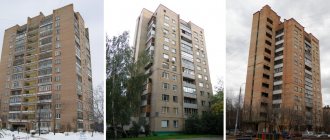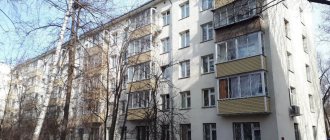At the stage of creating a series of 9-story residential buildings 1MG-600, it was assumed that it would replace five-story panel buildings in mass housing development.
In parallel with houses of frame-panel load-bearing structure, to which the 1MG-600 series belongs, panel projects (such as II-49) were developed, which, due to better economic efficiency, became widespread.
In total, 20 houses of the 1MG-600 series were built in Moscow in the period from 1964 to 1974 in two modifications:
- Multi-section houses (number of entrances from 4 to 6) 1MG-600-1.
- Single-section towers (with 1 entrance) modification 1MG-600-3.
Houses 1MG-600-1 and 1MG-600-3
In Moscow, houses of the 1MG-600 standard series can be found on Klenovy Boulevard (7, 9, buildings 1 and 2), on Sudostroitelnaya Street (6, 8, building 1, 12, 14/ 16, building 23 building 2, building 25 building 2, building 27 buildings 2 and 3, building 38 building 2, building 43 building 1, building 45), on Yakornaya street (building 7 , no. 8, buildings 1 and 2, no. 9), as well as on Shvernika Street (no. 5, no. 2, no. 9, no. 4).
Apartments in series 1MG-600
The series includes 1, 2 and 3 room apartments with a living space height of 260-264 cm, which varies depending on the floor design.
| Apartment area (m²) | General | Residential | Kitchen |
| 1 room | 29-31 | 18-20 | 8.6-9.1 |
| 2-room | 39-52 | 28-35 | 7-7.5 |
| 3-room | 63-66 | 42-48 | 6.5-9 |
The bathrooms in one-room apartments are combined, while in the rest they are separate, but all with a compact bathtub only 150 cm long.
Cost of repairs in a ship's house
Stalin renovation Inexpensive kitchen renovation Budget renovation of Khrushchev apartment Repair of 507 series Repair of 504 series 2-room, three-room apartment 42 sq. m. apartment 37 sq.m.Bathroom renovationturnkey studiorenovation of offices and commercial premises
Economy class
Economy class repair
- 1.5 year warranty
- Express
from 3,500 rub.
Cosmetic
Redecorating
- 2 year warranty
- Turnkey work
from 5500 rub.
6600 rub. m2 Capital
Major renovation
- 1 year warranty
- Discounts on materials
from 7,500 rub.
Designer
Designer renovation
- 3 year warranty
- Individual design
from 10,500 rub.
European-quality apartment renovation
European-quality apartment renovation
- 3 year warranty
- Design project as a gift*
from 7,500 rub.
Chernova
Rough finish
- 2 year warranty
- Acceptance from the developer
from 2,100 rub.
View works
Elite
- 3 year warranty
- Discounts on materials
from 10,500 rub.
Layout in houses 1MG-600
The layout of the apartments in the series can be considered successful in some ways - the 1-room apartments have relatively large kitchen areas, although some of them do not have a balcony.
All two- and three-room apartments have loggias or balconies, but their kitchens are small, and one of the two-room apartments has adjacent rooms.
Floor plan of house 1MG-600
The layouts and apartments of the 1MG-600 series are in many ways similar to the 1MG-601 series, which has become much more widespread.
"Ships" of developed socialism
Houses of the 1-LG-600 series are associated with the 70s of the last century and received their common name due to the “ship” coloring and facades similar to deck superstructures. Thanks to the continuous ribbons of windows and loggias along the facade, these houses are easily recognizable: while late Khrushchev-era buildings are often called five-story Brezhnevkas in sales advertisements, then “ships,” unlike other types and series of mass housing, are not confused by anyone with any other mass-produced houses.
The basis for the “ship” development was laid by the Decree of the Central Committee of the CPSU and the Council of Ministers of the USSR “On measures to improve the quality of housing and civil construction” of 1969, which set the task of “further increasing the artistic, aesthetic and operational level of new housing.” Actually, these houses with “improved aesthetics” became “ships,” various modifications of which in the early 1970s the leading design institute LenZNIIEP “baked” like pancakes for the Avtovsky House-Building Plant (DSK-3). And the first testing ground for “ship” development turned out to be the territories of the Kirov and Krasnoselsky districts closest to the plant. According to the Group’s Center for Research and Analytics, in the modern apartment market, housing in “ships”, along with apartments in the first mass-produced buildings – Khrushchev’s five-story buildings, is considered the most democratic. Today, the offer price for one-room apartments in “ships” starts at 2.8 million rubles. in urban “dormitory” areas (mainly Vyborg, Kirov and Krasnoselsky) and 2.6 million rubles. in the suburbs (Krasnoe Selo, Sertolovo). That is, they are comparable to the starting prices of Khrushchev apartments. Prices for “ship” three-room apartments in the city start at the psychological mark of 4 million rubles. (initial prices for “three rubles” in Khrushchev’s five-story buildings are noticeably lower - about 3.6 million rubles).
Ship's suite Compared to the first nine-story Brezhnev buildings, the houses of the 1-LG-600 series are buildings of a new generation. From the point of view of urban planning, they differed from the early serial nine-story buildings, like a scarce wall of furniture (the cherished dream of a tenant in the late seventies) from an awkward three-door wardrobe. The 1-LG-600 series was a kind of “constructor set”, a furniture set that made it possible to “furnish” new neighborhoods, which were being developed on a grand scale in those years. When developing the series, the so-called block-sectional design principles were applied for the first time.
The range of standard houses of the 1-LG-600 series included houses with different numbers of entrances (block sections) and floors (from five to fifteen). Among the new trends in design are various planning solutions for houses oriented along parallels (east-west) and meridians (north-south). Meanwhile, if you believe the construction and architectural publications of that period, in addition to standard block sections, corner, rotary, T-shaped, “trefoil” sections with built-in and built-in-attached stores were developed, which were supposed to give the blocks of new buildings a modern dynamic look. Fortunately for today's residents of St. Petersburg, these plans were not realized: the current state of “ship” facades, enclosing aerated concrete panels with crumbling coating, unstable coloring and cramped loggias and kitchen windows at chest level is a serious problem for both residents and service organizations.
Tarnished reputation The consumer qualities of the apartments have changed little compared to the houses of the Khrushchev period: the same ceilings of 2.5 m, kitchens of 6.2-6.3 square meters. m (exception is the “cooperative” modification 1-600A70 with kitchens 9.3-11.9 sq. m). The designers honestly strived to bring the range and characteristics of apartments closer to the needs of the population - taking into account the demographic situation - and to provide each family with a separate apartment. But in a housing shortage, “single family” often meant three generations. Thus, a family of four to six people was considered as the tenant of a multi-room apartment. The area of the rooms did not increase, but combined bathrooms were abandoned, and the apartments were provided with built-in wardrobes, which “ate up” the area of the already cramped rooms and hallways. But during the 600th series, residential areas were built up aggressively and on a grand scale.
The history of the rush jobs that accompanied “shipbuilding” ended tragically. At the end of February 1979, in the north of Leningrad, a fifteen-story building of the 1-LG-600 series, built from foundation to roof in just a month (!), collapsed. Fortunately, no one was hurt: when the building, which had been erected under the roof, began to crack, the installers managed to sit in a trough for concrete mortar placed by the crane operator and leave the site in it. As usually happens in such cases, the culprit was assigned to abnormal frost: everything happened at the moment when the frozen but not set concrete thawed. Despite the fact that the designers were not found to be at fault for what happened, the high-rise “ship” development was hastily curtailed, and the neighboring, also almost finished, house was dismantled.
The European standard did not take root. In Brezhnev’s times, the elegant residential buildings of the “ships” seemed comfortable, cozy and even prestigious for some time, and in advertisements for the exchange of apartments they were sometimes designated as “houses of the Czech series.” This was how they hinted at the European origin of these buildings (everything of high quality in those years was associated with imports, and imports were predominantly Eastern European). Although, in fairness, we note that in different regions of the former USSR, for some reason, the definition of “Czech” included different types and series of houses. One of the characteristic features of the “ship” is the kitchen with a window sill at chest level. It was assumed that this arrangement of the window would help residents rationally manage a small space: a dining table, sofa or buffet could be placed under it. In the first modifications of houses of the 1-LG-600 series, there are not only kitchens with an overhead window, but also bedrooms: this is the only way to squeeze a double bed into a room of a little more than 6 square meters. m. Moreover, this makes the bedroom, from the windows of which only the sky is visible, truly look like a ship's cabin.
Meanwhile, windows located near the ceiling are indeed borrowed from European experience (Soviet builders studied the practice of constructing social housing in post-war France, Poland and Czechoslovakia), but did not take into account that such solutions are appropriate in spacious small-family apartments with non-isolated halls and living rooms. For a Soviet tenant, such an attribute of a European apartment turned out to be alien and soon turned into a symbol of the cheapest and most uncomfortable housing. In addition, furniture capable of somehow ennobling such a room was in short supply during the years of developed socialism.
Pros and cons The reputation of the “ship” in today’s apartment market is really unimportant. Primarily due to the fact that the ever-reforming operating organizations do not have time to update the facades, which is why the lion’s share of the “six hundredth” houses look sloppy (however, there are pleasant exceptions in this regard). In addition, having borrowed construction technologies and design solutions from countries with warmer climates, our designers, as usual, “forgot” to insulate the outer walls: in the event of heating failures, apartments in “ships” freeze out quite quickly (“ships” - some of the coldest houses in St. Petersburg). Another common problem with all modifications of the 1-LG-600 series is practically ineradicable leaks on the facades. However, these shortcomings can be combated by filing complaints with service organizations.
But, besides the disadvantages, the “ship” also has obvious advantages. Its design (load-bearing frame and external walls made of lightweight curtain panels) provides a decent margin of safety. Therefore, the entrances and apartments in such houses are usually in good condition. However, due to the load-bearing internal walls of the apartments, they cannot be redeveloped. The upper location of the windows is also a disadvantage, but the modern abundance of furniture allows us to turn it into an advantage and finally arrange sofas, beds and household appliances exactly as the designers intended. “Ship” loggias, being glazed, can minimize the consequences of leaks and increase the usable area. Most of the houses of the 1-Lg-600 series are located in residential “dormitory” areas. This means that apartments in “ships” will continue to be found on the secondary housing market for a long time to come as quite liquid and relatively comfortable economy-class housing.
Modifications of “ships” 1-LG600A Houses with the number of entrances from three to nine. In suburban areas there are five-story (without elevators) and seven-story buildings of this modification, but in most cases these are nine-story buildings. 1-LG600A - the main development of the “dormitory” quarters of the Kirov and Krasnoselsky districts; this series is also available in Primorsky, Vyborgsky, Kalininsky and Frunzensky.
1-LG600A-1, 1-LG600A-8 Spot single-entrance houses. 9, 12 or 15 floors. Mainly Kirov and Krasnoselsky districts.
1-LG600A/70 Modernized “ship” designed specifically for housing cooperatives (7, 9, 12 or 15 floors). Construction of these houses began in 1973 and continued until the early 1980s. The main difference from the first modifications is the sections with protrusions and increased to 11.9 square meters. m of kitchen area. They were built in Krasnoye Selo and Gorelovo, Krasnoselsky, Kirovsky and Primorsky districts.
Text: Philip Urban
Design and features of buildings 1MG-600
In general, houses of the 1MG-600 series are distinguished by fairly good thermal insulation and high-quality construction parts.
A residential building of the 1MG-600 series is being built
Due to the design features, the range of building materials used in these houses was very diverse:
- The supporting frame consists of vertical columns and horizontal crossbars made of high-strength reinforced concrete.
- The stability of the structure is given by load-bearing walls (stiffening membranes), made of reinforced concrete panels located along and across the building.
- Interfloor ceilings are assembled from hollow-core reinforced concrete slabs.
- Interior partitions are made of gypsum concrete slabs.
- The external walls in the series are block.
On each floor there are from 5 to 6 apartments, which are served by a single passenger elevator located along with a garbage chute on the interfloor area.
Incidents [edit | edit code]
On February 27, 1979, in Leningrad, a complete collapse of a 15-story building of the 1Lg-600-1 series at 10 Kustodieva Street occurred due to a violation of the technology for installing facade panels. Another house being built nearby was stabilized with logs and subsequently dismantled. The cause of the collapse was the sealing of the joints of the façade panels with a cement mixture instead of gernite gaskets. Hardening in the cold, the cement mortar mixed with salt caused improper redistribution of loads across the structural elements of the house, which led to the destruction of part of the load-bearing consoles and collapse. Casualties were avoided thanks to the tower crane operator, who removed the installers from the building in a tub of this solution [3] [4].
Redevelopment of apartments in the 1MG-600 series
In the series, redevelopment of apartments does not pose any particular difficulties due to the fact that there are practically no load-bearing walls on their area, although the presence of columns and crossbars must be taken into account.
In addition, the project provides built-in wardrobes in each of the apartments, the area of which can also be used for redevelopment.
As practice has shown, it is better to plan renovations with changes in the configuration and area of premises (redevelopment) together with designers who have complete information in this area.
Consultation on all issues related to the redevelopment of apartments and non-residential premises can be obtained from our organization free of charge.
Our specialists will prepare all the design documentation necessary to coordinate the repair, and will also be able to arrange turnkey redevelopment.
Calculator
Our company is engaged in apartment renovation in:
- Stalinka (ST);
- Khrushchev (KhR);
- Brezhnevki (BR);
- Houses of the 121st, 137th, 504th, 507th and 606th series.
Specialists visit the site before construction work. They take measurements and assess the condition of the premises, create a project, a work plan, and also approve the repair customer’s estimates.
We provide a guarantee on all work. Photos of finished objects that were repaired by our craftsmen are on the company’s official website.
Free call to a surveyor, estimate calculation Just leave your phone number and within 1-2 days you will receive a free consultation on design, major work, electrical, plumbing, cost of materials and timing of work!
Space-planning solutions.
The designed residential building consists of four large-panel block sections in E-600 series designs, designed on the basis of a typical ordinary block section P0-05-145 (2 pcs.), a corner section P0-05-20u (1 pc.) and an ordinary block - sections P0-05-102 (1 piece). The residential building is designed with 10 residential floors, technical floors: in the upper part (technical attic) and in the lower part (technical underground). Technical floors are intended for installing engineering systems and laying communications. The building has a plan shape close to L-shaped. The adjoining sections of the house are provided with an expansion joint along the blocking axes B, D with a difference in height of the floor level of the 1st floor. At the location of the expansion joint in the sections, external end walls are designed, the distance between the B and D axes is assumed to be 0.74 m. The dimensions of the house in blocking axes 1-3/A-D are 49.94 x 12.6 m, in axes 2-6/A-B - 70.80 x 12.6 m. Section PO-05-145 (in blocking axes 4-5/А-Б, 5-6/А-Б) has dimensions in axes 1с-7с/Ас-Дс - 24.0×12.6 m. Section P0-05-20у (in blocking axes 2-4/А-В) has dimensions in axes 1s-11 s/Ac-Ds - 24.0×12.6 m, in axes 2s-7s/As-Zhs - 19 ,2×10.8m. Section PO-05-102 (in blocking axes 1-3/G-D) has dimensions in axes 1s-7s/Ac-Ds - 30.0×12.6 m. The relative level of 0.000 is taken to be the level of the top of the technical underground floor slab, which corresponds to the absolute elevations in the Perm elevation system: 148.20 for sections PO-05-145, PO-5-20u (in axes 2-6/A-B); 146.90 for section PO-05-102 (in axes 1-3/G-D). Planning ground marks at the corners of the building are 147.85 - 145.40, existing ground marks are 147.85 - 145.70. The height of the 1st-10th floors is assumed to be 2.8m; height of premises (“in the clear”): 1-10th floors - no less than 2.5 m, technical underground - 2.03 m; upper technical floor (technical attic) - 1.78 m. The entrances to the residential entrances are designed from the courtyard facade directly to the 1st floor (+0.060). At the entrances, a porch with external open stairs and lifts for MGN is provided, double vestibules. The staircase and porch railings are 1.2 m high. The loggia slab on the 2nd floor serves as a canopy. To ensure evacuation, each section has a type L1 staircase with natural and artificial lighting. Exits from the staircase, incl. on the first floor are designed into floor-by-floor corridors. From the staircase on the first floor there is also an exit directly outside through the vestibule at minus 0.900. The width of flights of stairs is accepted to be 1.35 m, landings - not less than the width of flights. Fences for marches and platforms are metal, 1.2 m high. Within each floor (on interfloor areas) light openings with an area of at least 1.2 m2 are provided. Each residential section is equipped with a passenger elevator with a lifting capacity of 630 kg with stops from the 1st to the 10th floor. The elevator is adopted with the dimensions of the cabin “in the clear” - no less than 1.1mx2.1m (WxD), movement speed - 1.0m/s. The width of the corridors in front of the elevator entrances is accepted to be at least 2.1 m. The machine room is located in the superstructure volume above the staircase-elevator unit. The entrance to the machine room is designed from a staircase, along an additional metal ladder; a hatch measuring 0.8 x 1.2 m is provided in the floor for lifting equipment. Under the entire area of the building at minus 2.250, a technical underground has been designed for the placement of technical rooms and the laying of utilities. ITP is located in the technical underground of the section in axes 4-5/A-B. In the technical underground of each section there is one exit to the outside through a door with dimensions of 900x1560(11)mm or 900x1660(b)mm along an open external flight of stairs in the pit and one exit to the outside through a door with dimensions of 900x1560(b)mm or 900x 1660 (b) mm in a pit equipped with a stepladder. In the technical underground of the section in axes 4-5/A-B, both exits to the outside are provided via an open external flight of stairs in the pit: one through a door with dimensions of 900x1660(b) mm, the other (from the ITP side) through a door with dimensions of 920x1930(th) mm . A fence with a total height of 1.2 m is provided along the walls of the pits; the staircase in the pit is equipped with a handrail. The pits have drainage holes to release rain and melt water. In the technical underground of each section, vents with a total area of at least 1/400 of the technical underground floor area are designed, located along the perimeter of the external walls. On the ground floor of each section there are double vestibules with compartments at least 1.5 m deep and at least 2.2 m wide, outside corridors at least 1.7 m wide, a storage room for cleaning equipment, and a staircase and elevator unit. The sections in axes 1-3/G-D are designed with an electrical panel room, a HOA room, and a bathroom. The section in axes 4-5/A-B has an electrical panel. Electrical switchboards are located adjacent to non-residential premises; kitchens are located above the electrical switchboards on the 2nd floor. The entrances to the electrical switchboards are designed from the non-apartment corridor of the 1st floor. In the section in axes 2-4/A-B at the level of the 1st floor in axes 10c-11c, an internal through passage is designed with an additional entrance from the Ac side, equipped with a porch with an external staircase and a double vestibule. From the 2nd to the 10th floor of each section there are non-apartment corridors with a width of at least 1.7 m, a staircase and elevator assembly. The project provides one, two, and three-room apartments in the residential sections, located from the 1st to the 10th floor. Each apartment has designed living rooms, kitchens, bathrooms, hallways, corridors, glazed loggias. In the corner section, one-room apartments near axis 2 are designed with combined bathrooms; the remaining apartments have separate bathrooms. In the ordinary section in axes 4-5/A-B in a two-room apartment on the 1st floor, adjacent to the electrical room, there is a dressing room; in the remaining apartments, built-in wardrobes are designed in the hallways. All apartments located above the 5th floor have loggias equipped with a hatch and an external staircase connecting the apartments from the 10th floor to the 5th floor. Area (without loggias) of one-room apartments - 34.07-38.03 m2; the area of two-room apartments is 52.49-59.04 m2, the area of three-room apartments is 71.63-79.23 m2. The minimum area of premises is accepted: living rooms - 16.46 m2, in the corner section - 14.55 m2 (in one-room apartments), bedrooms - 9.12 m2, kitchens - 8.52 m2, in the corner section - 7.7 m2. The area of the bathroom is at least 2.48 m2, the combined bathroom is 2.72 m2. Kitchens in apartments are equipped with cookers and sinks. Bathrooms are to be equipped with a bathtub and washbasin; toilets - toilet; combined bathrooms - bath, washbasin, toilet. In each section, above the upper floors, a technical floor is designed (a “warm” attic) with a height of 1.78 m, intended for laying utilities and arranging technical premises (the elevator machine room at level +29.010 in the volume of the superstructure of the staircase-elevator block). In the technical attic level above the loggias, closed closed rooms are designed with access from the apartments on the upper floor (from the loggias via external ladders). There is no connection between loggias located on the technical floor level and the attic space. The exit to the technical attic is designed from the staircase. Ventilation ducts from the premises are discharged into the attic space. For ventilation of the technical attic, each section has a common exhaust shaft. A tray is provided under the exhaust shaft to collect precipitation and condensate. In places where pallets are installed, a waterproofing carpet made of 2 layers of roofing material is installed on the floor. The exit to the roof in each section is designed from the central part of the attic via an internal metal staircase located next to the exhaust shaft, with a platform in front of the exit. To climb to the roof of the superstructure above the staircase-elevator unit, a metal stepladder is provided. The walls of the building, including the plinth, are factory-finished panels, painted with façade paints. Interior decoration. Ceilings - water-based paint. Walls: in apartments - acrylic wallpaper, in kitchens and toilets - vinyl wallpaper, in bathrooms - ceramic tiles to a height of 1.5 m above the bathtub and water-based painting, in the HOA premises - wallpaper of improved quality, in the HOA bathroom - improved adhesive painting, in the rest premises, including technical and common areas - water-dispersion painting. In public areas, a “galosh” with EVA-27 paint to a height of 150 mm is provided. Floors: living rooms, kitchens, corridors, dressing room, HOA premises - linoleum on a heat-insulating basis; bathrooms, cleaning equipment rooms, electrical panels - ceramic tiles; entrance vestibules, non-apartment corridors; landings, landings in front of elevators - ceramic tiles and concrete; technical rooms - concrete floors. In all rooms of the apartments, including bathrooms, on the first floors, the floor structure includes a heat and sound insulating layer made of Penoplex-35 slabs 40 mm thick with a screed device using cement-sand mortar M200 40 mm thick. In the bathrooms on all floors, the floors are waterproofed with two layers of polyethylene film.
How to improve an apartment in a ship-type house
Let's consider the most popular aspects of repairs in a houseboat.
- Thermal and noise insulation. There are many construction technologies that allow you to quickly and inexpensively solve the problem of insulation and eliminating unnecessary noise.
- High windows. Today this is not a problem, but a unique design element that can be interestingly played out using modern furniture.
- Loggia. Having carefully insulated the outer part, the loggia can be easily connected to the room, thereby significantly increasing its area, or designing it as a separate cozy room - an office, a winter garden, a relaxation area, etc.
It should be noted that the inconveniences of apartments in house-ships are not unavoidable. With a competent approach to design and a thoughtful choice of materials, an apartment in a 600-series building turns into a cozy and modern home that meets the requirements of comfort and aesthetics.

